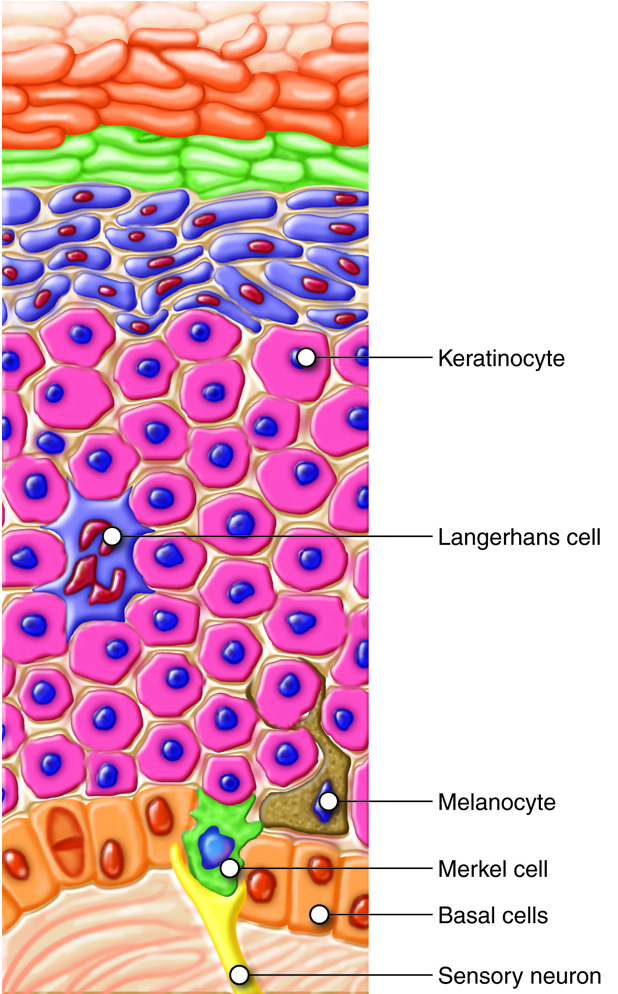
Introduction:
In this article, we delve into the wonder of skin colour. By gaining a deeper understanding of its vital role in shielding our bodies and embracing effective skincare practices, we can unlock the full potential of this incredible organ. Let us prioritise its care, harnessing the power of cleansing, hydration, and sun protection, to revel in a lifetime of vibrant health, timeless beauty, and radiant vitality.
I. What cause Normal Skin colour ?

a) Melanin:
- Melanin, a pigment produced by cells called melanocytes, determines skin colour.
- Melanocytes in the deeper layer of the skin known as the stratum germinativum produce melanin through a complex biochemical process called melanogenesis.
- Genetic factors, including variations in genes such as MC1R and TYR, regulate the production of melanin.
- Eumelanin, responsible for brown and black pigmentation, and pheomelanin, contributing to red and yellow tones, are different forms of melanin.
- The amount and type of melanin produced by melanocytes, and its absorption in the skin determine our skin colour.
- Melanin production can be influenced by factors such as hormonal changes, certain medications, and inflammatory processes.
b) Carotene:
- Carotene, an antioxidant pigment found in certain vegetables, can influence skin colour.
- When you eat foods that contain a lot of carotene, like carrots, sweet potatoes, and spinach, it gets stored in the layer of fat just below your skin.
- This can give your skin a slight yellow or orange tint. Carotene also serves as a provitamin, meaning it can be transformed into vitamin A, which is crucial for keeping your skin healthy.
- The presence of carotene is particularly noticeable in areas with thinner skin, such as the palms and soles.
c) Haemoglobin:
- Haemoglobin is a protein that carries oxygen in our blood and it also influences the colour of our skin. When haemoglobin is filled with oxygen, it gives our skin a rosy or reddish look, particularly in areas where blood flow is high, like our cheeks.
- Reduced oxygenation or poor blood circulation can result in a paler or bluish tint to the skin, known as cyanosis.
- Factors such as blood vessel dilation or constriction and the presence of other pigments in the skin can affect the visibility of haemoglobin’s influence on skin colour.
II. Keratinisation:

- Keratinisation is a complex process that ensures the strength, resilience, and renewal of our skin.
- The process begins in the basal layer (stratum basale) of the epidermis, where cells divide and undergo differentiation.
- Differentiation involves changes in gene expression, leading to the production of specific proteins, including keratin.
- As cells move through the layers of the epidermis, namely the spinosum, granulosum, and corneum, they accumulate keratin and undergo structural changes.
- Keratin is a strong and durable protein that gives our skin its structure and helps it withstand physical pressure and environmental factors. Our outermost layer of skin, called the stratum corneum, constantly sheds dead skin cells, allowing for the continuous renewal of the skin.
- This process reveals fresh and healthy skin underneath. The rate at which keratinization occurs can be influenced by factors such as age, hormonal changes, and skin conditions like psoriasis or eczema.
III. Melanin:
- Melanin, synthesised by melanocytes in the stratum germinativum, is responsible for the pigmentation of our skin.
- The production of melanin, the pigment that gives color to our skin, is influenced by both our genes and our environment. Genetic variations in certain genes, like ASIP, SLC24A5, and OCA2, contribute to the differences in how much melanin is produced and how it is distributed in our skin.
- When our skin is exposed to sunlight, specifically the ultraviolet (UV) radiation it contains, our melanocytes (specialized cells that produce melanin) are stimulated to produce more melanin as a protective response to DNA damage caused by the UV rays.
- This increase in melanin synthesis is triggered by the activation of melanocyte-stimulating hormone (MSH) receptors on the melanocytes, resulting in skin tanning.
- The distribution and density of melanin within the skin determine the wide range of skin tones observed among different individuals and ethnicities.
- Melanin not only provides colour but also plays a crucial role in protecting the skin from UV radiation by absorbing and scattering the harmful rays.
IV. Importance of Sun Protection:
- Sun protection is essential for maintaining skin health and preventing damage, regardless of skin colour.
- UV radiation from the sun consists of UVA and UVB rays, both of which can penetrate the skin and cause harm.
- UVA rays can prematurely age the skin, leading to wrinkles, fine lines, and sunspots.
- UVB rays are the primary cause of sunburn and can also contribute to the development of skin cancer.
- Effective sun protection measures include wearing sunscreen with broad-spectrum protection, applying an adequate amount, and reapplying regularly.
- Seeking shade during peak sun hours, wearing protective clothing, and using sunglasses and wide-brimmed hats can further reduce UV exposure.
- It is important to practise sun protection year-round, as UV radiation can still reach the skin even on cloudy or cool days.
Conclusion:
Understanding the factors that contribute to normal skin colour allows us to appreciate the complexity and beauty of our skin. By practising proper skincare, including cleansing, moisturising, and sun protection, we can maintain the health and radiance of our skin. Consulting with dermatologists or skincare professionals can provide personalised advice for addressing specific skin concerns and choosing suitable skincare products. Embracing a holistic approach to skincare that encompasses lifestyle factors such as nutrition, hydration, and stress management further enhances our skin’s well-being. Let us unlock the full potential of our skin by nurturing it with care and protection, enabling us to enjoy vibrant health, timeless beauty, and radiant vitality throughout our lifetime.

